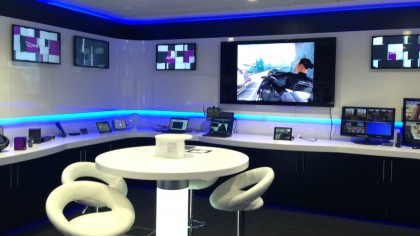Why ray tracing will take graphics beyond your imagination
UK gadget fun house takes the next step
"Today's graphics, if you look around, they look very nice, some of them even look wonderful in terms of the realism, but it's all faked because the current technologies out there do not model light."
"If an artist wants to create a nice title, they have to spend a lot of time recalculating the fact of light from every potential scenario in the scene, says Yassaie. "But if the lighting is supported in the hardware, it's a bit like this room. You can define the spotlights, the window light etc, and everything else just works. So the content creation would be easier. It would look more beautiful."

Yassaie tells us that he expects to see ray tracing used in everything from games to Hollywood movies. The potential is huge. But it will also open up the process in a way that will make it more accessible for the less experienced designers.
"From a point of influence, what YouTube did for user-generated video, ray tracing will do for user-generated graphics," says Yassaie. "There will be a situation where there will be tools and things where ordinary people can create pretty nice looking graphics."
Yassaie believes that the technology will start making its way through more sizeable mediums before it shrinks down. "This technology is destined for mobile but you'll probably see it appearing in tablets and gaming consoles, and then eventually finding itself in mobile," says Yassaie.
The rebirth of AR?
Another potential interesting application of ray tracing is in augmented reality. While AR is still perceived as an awkward gimmick right now, ray tracing promises to make the idea practical. Specifically, Yassaie says, when it comes to online shopping.
"You could take a picture of your room with your camera and then you can get a nice model on the computer. You can drop the product there and walk around it," says Yassaie. "I think that will change the online experience of shopping."
Get daily insight, inspiration and deals in your inbox
Sign up for breaking news, reviews, opinion, top tech deals, and more.
And the even better news is that it might not be years before we see ray tracing used in consumer devices. In fact, it might not even be half a decade.
"I think you'll begin to see that technology in a couple of years," says Yassaie when we ask when we might start finding ray tracing in smartrphones. "I think within five years it will be in everything but along the way it will just promulgate."
However, getting Yassaie to talk about any specific future products is an impossible task. TechRadar drops the Apple bomb but he won't talk about his possible involvement in the next iPhone. He does say, though, that he thinks smartphones might have earned their "smart" title a little too early.
"They're not really that smart, and they actually have to live up to that name a little bit more," he says. "You've got all this information available to you but if they were a bit more intelligent, knew a little more about you, and presented the data in a more sensible fashion..."
Yassaie pauses to think for a moment. "I have no doubt the UIs will get better," he says. "That puts completely different requirements on the graphics." As the sports car demo sits just feet from Sir Yassaie, it looks like Britain has already found the solution.
Hugh Langley is the ex-News Editor of TechRadar. He had written for many magazines and websites including Business Insider, The Telegraph, IGN, Gizmodo, Entrepreneur Magazine, WIRED (UK), TrustedReviews, Business Insider Australia, Business Insider India, Business Insider Singapore, Wareable, The Ambient and more.
Hugh is now a correspondent at Business Insider covering Google and Alphabet, and has the unfortunate distinction of accidentally linking the TechRadar homepage to a rival publication.
